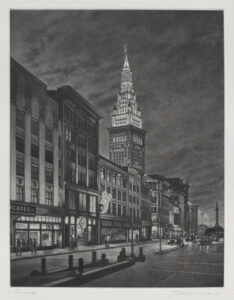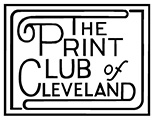 Pinnacle, is the Print Club of Cleveland’s Publication No. 99 for the year 2021.
Pinnacle, is the Print Club of Cleveland’s Publication No. 99 for the year 2021.
The scene in Pinnacle is easily identifiable as the Public Square area of downtown Cleveland. Juxtaposing the lower facades of Euclid Avenue with Terminal Tower in the background, and the Soldiers’ and Sailors’ Monument in the distance, Mershimer explores the playful curves of a neon sign’s bowling pins against the formal details of the rigid architecture.
Pinnacle, 2018. The Print Club of Cleveland Publication No. 99 for 2021.
Frederick Mershimer (American, b. 1958). Mezzotint; sheet: 38.1 x 47.6 cm (15 x 18 3/4 in.). The Cleveland Museum of Art, Gift of The Print Club of Cleveland 2021.184
